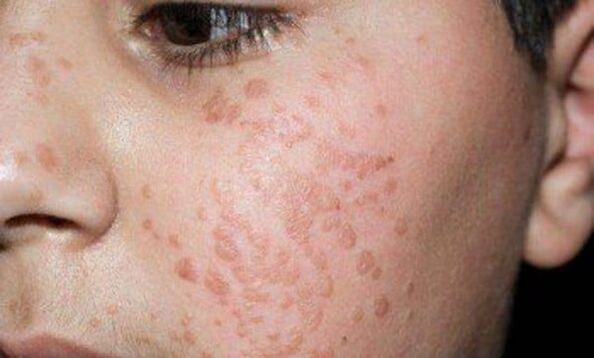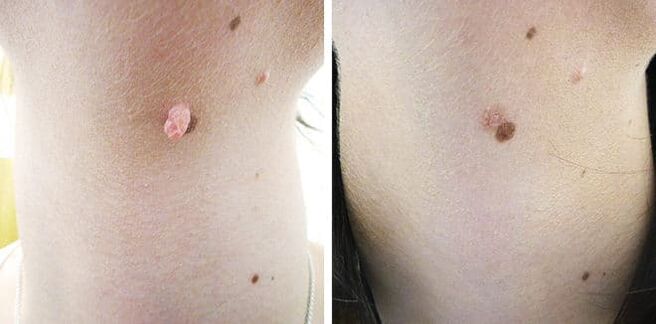Papillomas and condylomas are small growths on the skin that are viral in nature. You should be able to distinguish between them in order to observe potentially dangerous formations in a timely manner and take the necessary measures. The main thing that distinguishes a papilloma from a condyloma is the type of virus-pathogen.
Causes of neoplasms
Human papillomavirus (HPV) has more than a hundred different types. HPV enters the body through domestic contact or through unprotected sex. The possibility of the child being infected from the mother while passing through the birth canal.
Growth formation indicates rapid cell division in the basal layer of the skin. This occurs under the influence of the virus, the activation of which in most cases is associated with a decrease in immune defenses. Depending on the strain, papillomas or condylomas appear on the body.
Characteristic features of papilloma
Papillomas are benign neoplasms that cause no discomfort, except aesthetics. Characteristic features of papilloma:
- soft homogeneous structure;
- the presence of feet;
- small size (up to 10 mm in diameter);
- simple pigmentation.
Papillomas are localized in any part of the body, except the mucous membranes of the genitals. As a rule, the color of its growth varies from natural skin color to pink, but highly pigmented papillomas are also not pathological. Hair growth on the body of a papilloma is a variant of the norm.

Papillomas are harmless if they do not bother the patient and do not suffer unintentional injuries in daily life. The formation of this type of growth is due to the action of viral strains 2, 7 and 28. You can be infected with this type of HPV in daily life and during sexual intercourse.
Characteristics of genital warts
Warts are of two types - pointed and wide growths. The first type appears with HPV infection, and extensive growth is one of the symptoms of syphilis.
The localization location of genital warts is the mucous membranes, especially in the urogenital area, as well as the folds of skin that experience friction against clothing.
The structure of genital warts is papillary. Its formation is attached to a thin stem, its growth is channeled through small vessels and capillaries. Unlike papillomas, condylomas are often inflamed, ulceration of body growth is possible.
Genital warts are caused by 16, 18, 54 virus strains. This type of HPV is potentially dangerous, especially for women. There is a direct link between this type of virus and the development of cervical cancer. Infection occurs through sexual intercourse.
How to distinguish papilloma from genital warts?
External differences between growths are easily observed in photos - homogeneous papillomas, while condylomas have a fine papillary structure.
- The difference between papillomas and warts lies in the color of the growth. Papillomas can be very pigmented, the color of the warts is usually mild and does not differ from the mucous membranes.
- HPV, which provokes the development of papillomas, is transmitted through household contact, using personal hygiene products, and even through handshakes (in the presence of skin microtraumas). Warts are only sexually transmitted.
- Warts become inflamed. Papillomas can grow in size, acquiring signs of inflammation and pain, but only as a result of traumatic effects.
- The shape of the papilloma is dominated by a round or oval "head" located on a soft stem. Condylomas have irregular outlines, can be arranged in clusters. For genital warts, narrowing from the stem to the tip is characteristic, which makes it possible to distinguish them from papillomas.
- The emergence of growths of various types is due to various types of viruses.

It is important to remember the main difference between papillomas and warts - growths on the genitals and mucous membranes must be removed.
Why is growth dangerous?
Papillomas and condylomas are conventionally considered safe neoplasms of the skin, but the risk of benign cell degeneration into malignant cells is higher in the latter case.
Condyloma is a skin manifestation of the action of an oncogenic virus type. Studies over the years have identified a link between HPV and cervical cancer. Timely diagnosis with removal of genital warts can help reduce the risk of cancer in women.
Growth can occur not only on the skin and external genitalia, but also in the vagina and in the cervix. Due to the peculiarity of blood circulation in the genitals, condyloma gets sufficient nutrients and is able to grow quickly. In gynecology, there are cases when the condyloma located in the vaginal wall is up to 10 cm in diameter.
Instructions for disposal
Warts must be removed, even if not causing discomfort. This is mainly due to the risk of sexual partner infection.
To remove a papilloma that is present in the skin, or not, is a personal matter for each patient. The risk of benign papilloma degeneration into an oncological neoplasm increases when its growth body is damaged. This can be caused by rubbing clothes, accidental damage to nails or wipes during hygiene procedures.
You should see a dermatologist if:
- the papilloma has increased in size;
- when pressed, discomfort is felt;
- bleeding or purulent discharge is observed;
- the skin around the growth becomes inflamed.
Removing the buildup is five minutes. The procedure is almost painless. It is important to understand that timely diagnosis will allow accurate detection at the beginning of cell degeneration and stop the progression of oncology.
How is accumulation removed?
Any skin growths should be removed by a professional. Self-cleansing of papilloma with the help of folk remedies is not always effective. Removal of genital warts at home is strictly prohibited.

Before the procedure, it is necessary to conduct a series of inspections. First of all, the patient's blood is examined to find out the type of virus that causes the appearance of the neoplasm.
With multiple condylomas, patients are given antiviral and immunomodulatory therapy. This allows you to stop the spread of the virus and adjust the immune system to fight HPV. To get rid of genital warts, ointments with immunostimulants in the composition (for example, drugs based on interferon) help. Such medications are available in the form of suppositories, which allow you to successfully fight growths in the vaginal wall.
Methods to get rid of accumulation:
- cryodestruction;
- electrocoagulation;
- laser burning;
- removal with a radio knife;
- excision with a scalpel.
When the genital warts are removed, the tissue obtained as a result of the procedure is sent for histological analysis. For this purpose, surgical incision or laser removal is indicated.
Electrocoagulation is the cauterization of a neoplasm. This method works well to get rid of small papillomas.
Cryodestruction is used to remove neoplasms on the skin, but not on the mucous membranes. Liquid nitrogen is applied to the growth, which causes cell necrosis, as a result, the papilloma disappears just like that.
Radio wave removal or a radio knife is an effective and almost painless method of getting rid of genital warts. Under the influence of radio waves, neoplasm cells are destroyed. The procedure is performed under local anesthesia.
Laser fatigue of genital warts is indicated by the presence of a large number of growths. The advantage of this method is the formation of vessels and capillaries that feed the formation. As a result of exposure, there are no traces on the skin, the risk of bleeding is excluded. Complete recovery of the epidermis after removal occurs in 5-7 days.
To get rid of genital warts, folk remedies are not used because of the high risk of damage to the mucous membranes by aggressive components of the composition. Alkaline pharmaceutical preparations are also prohibited.
To find out how warts differ from papillomas, photos will help. You are recommended to see your doctor if a formation appears on the genitals, and do not try to remove it yourself.















































































